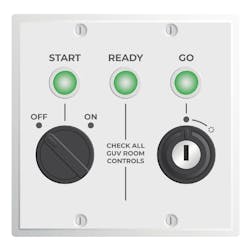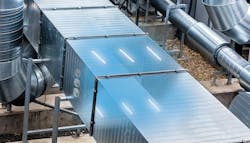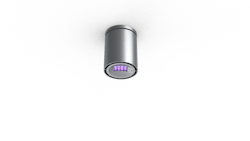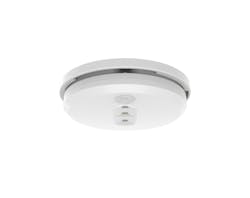Ultraviolet (UV) radiation in the UV-C band (100–280 nm) will deactivate most viral, bacterial, and fungicidal pathogens given the proper dose. Moreover, the radiometric energy at wavelengths below the human visual range seems more acceptable and easier to deploy than yet more chemical disinfectants. Educational facilities would be a natural fit for such an environmentally clean disinfection scheme. But UV-C carries its own risk to human skin and eyes, and it can degrade surfaces of chairs, counters, and more. So we set out to see how schools might be using UV-C only to learn that most are suffering from paralysis by analysis. Still, we will examine UV-C approaches from lighting manufacturers that could serve well in educational facilities and cover some early examples of use.
This article is the first in a planned series of UV-C-centric articles we are publishing in 2021 with the works bundled into special reports in three different issues of the magazine. As mentioned above, this issue will look at education. Later in the year, we will look at healthcare facilities and then at commercial spaces. This issue includes a second UV-centric article contributed by Excelitas that focuses on available UV-C sources and on how to determine the dosage that will deactivate a pathogen such as SARSCoV-2. In this article, we also have a sidebar below that adds to the dosage knowledge base.
The lighting manufacturers pursuing germicidal UV-C opportunities have largely settled on two classes of applications for open spaces — air disinfection and surface disinfection. Some of them also offer disinfection chambers to cleanse items ranging from mobile phones to school supplies to medical gear. The proprietors of UV-C products range from startups to the largest companies in the lighting business including Acuity Brands, Signify, Cooper Lighting Solutions (a Signify business unit), GE Current, and Osram. The product announcements that have been like a deluge into our email inboxes in the past year range from poorly conceived and clearly dangerous to extremely innovative. This germicidal UV-C segment is not an easy space to wade through, and we understand why educational institutions are struggling to deploy the technology.
For our purposes in this article, we will mostly ignore the portable or mobile UV-C implementations. For example, we covered a UV-C robot being used to disinfect the passenger compartment on commercial jets. Similar robots are being touted to disinfect restaurants or school classrooms. Safe use of such products is often left to the discipline of the people using it. Likewise, we wrote about United Airlines using a handled device to disinfect the flight deck on jets. Such an application requires great caution to protect the user.
Here we will focus on UV-C products that are meant to be firmly affixed to building infrastructure. Some get buried inside HVAC air-handling equipment. Many are like traditional light fixtures but may require significant safeguards so that they are never powered on with people present. Some of the products meant to be permanently affixed are proving to be safe for use with people present. Most of the products in the market today use legacy mercury lamps, although UV-C LEDs play in some applications.
Moving quickly
To get an idea as to how quickly lighting manufacturers have moved relative to UV-C, consider Cooper Lighting. Before June 2020, the company had no UV business. The company entered the market in June and launched what is perhaps the best dedicated website on the topic, mixing educational and product information. Ken Walma, vice president and general manager with Cooper, said the company had the advantages of parent Signify having been in the UV business a very long time and also that Cooper still had legacy fluorescent fixtures in its portfolio that could easily be adapted for use with UV-C tubes.
If you look at some of Cooper’s images including the restroom photo we have published (Fig. 1), it’s clear the company foresees the potential for essentially two lighting systems installed in the ceiling. The restroom image shows two different sets of UV-C fixtures installed for surface disinfection.
We asked Walma about the cost of having both visible light and UV-C systems throughout a facility. The operational cost would be negligible because that germicidal UV-C would be used for short cleansing cycles. But the capital expense would be significant. Walma replied, “The value proposition of health is an order of magnitude different.”
Moreover, we are already seeing products that integrate UV-C and visible light into the same fixture, or visible light and UV-C air disinfection in the same fixture. Such integration will lower capital costs. Still, assuming the COVID-19 vaccine works as promised, will settings such as educational facilities pay the price? Walma said, ”It will sell and become a market.”
Pilots to deployments
Walma said Cooper has supplied “hundreds to thousands” of pilot UV-C installations where organizations bought the technology for evaluation and potential broader deployment. He said many of those pilots are in educational facilities. Unfortunately, we failed to find an educational administrator or facilities manager to discuss such projects with us. Walma said the bulk of the early pilots are focused on surface disinfection where the UV-C fixtures only deactivate viruses that the radiation reaches. In other words, pathogens under a counter would not be deactivated.
Walma suggested that air disinfection would become more prevalent over time, and that’s in part due to researchers learning more about airborne transmission of SARS-CoV-2. The usage model is also simpler. You can leave such systems operating continuously whereas surface systems are used sporadically and require safeguards to avoid operation with people present. Indeed, Cooper has a very sophisticated control system that combines an occupancy sensor, a key-secured arming control, and a rotary-switch activation to launch a disinfection cycle (Fig. 2).
HVAC integration
Air disinfection can come in several forms as noted earlier. Integration in the HVAC system of a commercial or education space would seem ideal (Fig. 3). Recently, Johnson Controls released details of such a project in a library. The Vernon Area Public Library in Lincolnshire, IL installed UV-C lighting grids (an array of UV-C tubes) inside two of the library’s air handling units (AHUs). Catherine Hawn, account representative of building services at Johnson Controls, said, “As part of our OpenBlue Clean Air suite of solutions, UV lighting helps our customers achieve healthy, safe, and flexible buildings, and we’re thrilled to help Vernon Area Public Library give the community increased peace of mind when they reopen.”
But there could be a decrease in overall effectiveness of the UV-C disinfection unit located in the HVAC system. Gary Trott, vice president of technology commercialization at Acuity, said consider a school classroom and how far a student may be seated from an HVAC vent, and how often the air is exchanged. He said, “When someone sneezes, there is a long path to disinfection.”
Acuity is basing its move into germicidal UV-C on partnerships and in air disinfection is aligned with UV Angel. That company has developed a troffer-style fixture with air intake on one end and clear air out on the other. The air flows through a UV-C disinfection chamber internal to the luminaire. And the middle of the troffer footprint includes a planar SSL light engine for visible light.
Acuity’s Trott believes many facilities managers will be more comfortable with a “rip and replace” of a troffer than an HVAC installation. Trott further said the localized air treatment approach will be far more predictable and allow facilities managers to know exactly how much air is being disinfected locally. Cooper’s Walma made a similar argument, saying that the company's customer communications indicate most prefer to rely on the ceiling lighting infrastructure rather than the HVAC system. Cooper doesn’t have such a fixture today but is clearly moving toward such a product.
We’ve seen numerous smaller companies develop troffer-style germicidal UV-C air systems. One we covered recently is Energy Harness, which worked with Purdue University to develop what’s called the Active-Airflow system. The troffer-style units have no visible lighting element, at least in the initial development. The products have been installed in two Central Indiana School Districts.
Energy Harness president Michael Fischer said the schools have been very pleased with the UV-C units. Fischer’s team utilized UV-C LEDs in the air chamber whereas UV Angel uses mercury tubes. As we have written and as is covered in the previously-mentioned Excelitas article, UV-C LEDs today generally lack the power needed for, say, surface disinfection, but can work well in specialty applications. Fischer won’t share exact architectural details of his product, but it’s clear that the company has developed a lengthy airflow chamber in the luminaire with LEDs spread throughout what must be some sort of serpentine design. Fischer said one unit uses almost 200 LEDs. What such a design accomplishes is essentially lengthening the UV-C exposure based on airflow (see sidebar below on dosage).
Wavelength and airflow add to dosage math
The article by Excelitas’ Pamela Lee and Marvin Ruffin on UV-C sources does an excellent job of describing the UV-C dosage required to deactivate SARS-CoV-2. Still, there are a couple of other angles we would point out, including wavelength efficacy and duration in air disinfection applications.
For surface disinfection, the math is relatively simple in that dose is intensity multiplied by exposure. But not all UV-C is created equal. We published a news article back in September 2020 about research done at the Boston University (BU) National Emerging Infectious Diseases Laboratories (NEIDL). The work examined efficacy of SARS-CoV-2 deactivation based on wavelength.
The NEIDL research showed that shorter wavelengths can deactivate SARS-CoV-2 effectively even over a very narrow band. For example, 260-nm radiation could deactivate the virus far more quickly than could 280-nm radiation. The ramification of this fact is that a product developer or someone installing a disinfection system can potentially make tradeoffs in intensity of the source and exposure time. It could even open the door for a UV-C LED proving viable in an application where the first thought might be that a mercury lamp would be required for sufficient intensity.
The air disinfection application only adds to the problem. In surface disinfection, exposure time isn’t a calculation but rather time on a clock. Exposure time in an airflow chamber equipped with UV-C sources depends on the length of the chamber and the speed of the airflow. It’s beyond our scope here, but airflow is impacted by a fan, pressure differences, system friction, and more.
Indeed, the dosage math gets far more complicated with airflow. To determine intensity, you must know distance from the source of the UV-C radiation to the target that will be disinfected. That number lies somewhere between the flux at the source and the flux at the far wall of a duct. If you make the air path longer you can more easily achieve dosage goals, but you also need more UV sources. ♦
Alternative air disinfection strategies
There are many more air disinfection strategies. Going back many years, facilities in areas such healthcare have used UV-C fixtures that radiate horizontally with a controlled beam to establish a disinfection layer safely above the heads of workers. Cooper and Signify have such products today that can affix to walls, columns, or the ceiling. We recently covered an installation of those products in a German grocery.
Ideally, however, it would be better to control the airflow and draw pathogens to the disinfection system. Appropriately-named Big Ass Fans has one such approach in a surprising form factor. The company is known for its ceiling fans with blade diameters stretching to the boundaries of a room. The company subsequently added some LED-based lighting capabilities to its products. And now the company is installing a UV-C LED light engine above the fan motor in some products with the UV-C radiating upward toward the ceiling and outward. See our cover image and you will see some violet emission above the fans in an auditorium setting.
The fans draw air from outside the diameter of the fan upward to the ceiling, through the UV-C bath and then back downward through the blades toward the floor. We covered the product concept in a recent news article. One installation of the fans has taken place in some classrooms at Carnegie Mellon University (CMU).
UV-C and people
Of course, all of this UV-C disinfection technology would be far simpler to use if you could just apply the radiation with people present. Affixed UV-C luminaires radiating downward would disinfect surfaces and air. But cleaning the air in an unoccupied space at night accomplishes nothing when an infected person walks into that same space the next morning.
There are at least two possible approaches to safely using germicidal UV-C in the presence of people — far-UV-C radiation and traditional UV-C at very low power levels. Most germicidal UV-C research and product development has been done in the range of 250–280-nm wavelengths. In part that range selection was driven by the fact that UV-C mercury lamps radiate at 254 nm.
Ushio, meanwhile, is a pioneer in excimer lamps that radiate at 222 nm in what has been called the far-UV-C sub-band. And Ushio has research that shows germicidal efficacy is excellent at the shorter wavelengths. As for safety, we first heard claims that the 222-nm radiation did not penetrate the outer layers of dead skin or the cornea of the eye last spring. Early tests were done with laboratory animals, but human research is progressing and suggesting such usage would be safe.
Back at the end of summer, we noted that the International Ultraviolet Association (IUVA), the National Electrical Manufacturers Association (NEMA), UL, and others had recommended against the use of far UV-C in the presence of people until more research could be done. Now it appears additional research is supporting a move forward with deployments. We could see such products enter the US market this year and UL guidelines emerge in the area of far UV-C.
Meanwhile, last summer Acuity struck a deal with Ushio. Acuity will have exclusive rights to sell visible-light products that also integrate Ushio’s far-UV-C light engine or module in North America. Acuity is developing the products under the Care222 brand (Fig. 4). Stay tuned.
GE Current is also offering a UV-C product that the company says can be safely used with people present. Back in September 2020, we covered the launch of the 365DisInFx brand that includes both UV-C products and UV-A products. The UV-C implementation, the LPU Series, is in the form of a ceiling puck and utilizes UV-C LEDs (Fig. 5). It radiates at levels deemed safe and documented in the International Electrotechnical Commission (IEC) 62471 Photobiological Safety for Lamps and Lamp Systems standard and also by the American Conference of Governmental Industrial Hygienists (ACGIH).
Moreover, Current recently released research that showed the LPU to be effective at deactivating bacteriophage MS2 aerosolized virus used as a surrogate for SARS-CoV-2. The test showed that the low levels of UV-C would deactivate 88% of the virus in four hours. But if operated continuously for 24 hours per day, the device would deliver 44% deactivation in two hours. Current said it expects faster results with SARS-CoV-2, suggesting 50% deactivation in one hour and 90% in three hours.
Current has made the LPU devices available for sale. Moreover, the company said a number of educational facilities were testing the products. The product looks and installs much like a smoke detector.
There is still plenty more to get to in future UV-C articles. Acuity has chosen pulsed-xenon sources for surface disinfection rather than mercury lamps. We have not covered any of the movement touting antimicrobial surfaces as a complement to germicidal UV-C radiation in virus disinfection. And by the time we publish our next special report, we will know more about the COVID-19 vaccine and whether or not that has taken any momentum out of the rush of UV-C products to market.
For up-to-the-minute LED and SSL updates, why not follow us on Twitter? You’ll find curated content and commentary, as well as information on industry events, webcasts, and surveys on our LinkedIn Company Page and our Facebook page.










